Bespoke polymers put SU start-up on map
Alec Basson
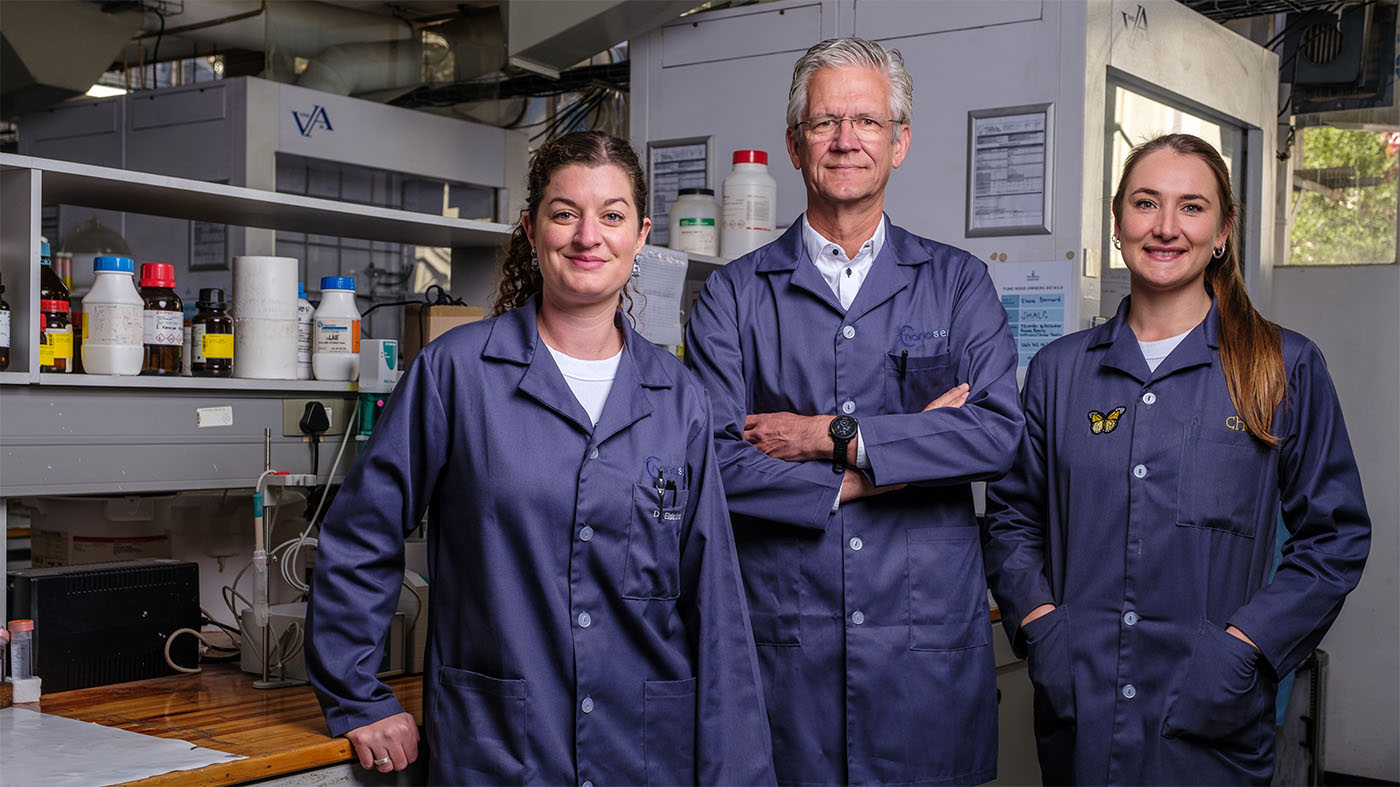
The Nanosene team: Dr Elaine Barnard (left), Prof Bert Klumperman, and Dr Gestél Kuyler. | Photo by Stefan Els
Imagine a world in which drug development is faster, more precise, and more affordable. As a scientific start-up company, Nanosene (Pty) Ltd is committed to reshaping the foundations of drug discovery and development to ensure just that.
Innovative polymer technology, developed during the PhD research of Dr Gestél Kuyler and licensed to Nanosene, is helping unlock new knowledge that can inform drug development and delivery in human cells on a molecular level.
The team, based at Stellenbosch University (SU), is focused on designing polymers for molecular drug target research. (A drug target is a specific molecule in the body, often a protein, whose dysregulation is closely linked to a particular disease process. By interacting with this target, a drug can influence its activity to produce a desired therapeutic outcome.)
Established in 2022, Nanosene is the first innovator and supplier of bespoke polymers in Africa. It is known for its development of the next generation of amphiphilic polymers — macromolecules containing both hydrophilic (water-attracting) and hydrophobic (water-repellent) components. These polymers are used to isolate membrane protein drug targets.
“Our focus is on molecular drug targets, especially membrane proteins,” Kuyler says. “These polymers are the key to unlocking previously inaccessible biologically active proteins in the cell membrane, which can accelerate therapeutic discovery and lead to more effective treatments for a range of diseases.”
Membrane proteins are the most pharmaceutically relevant protein class. At the same time, it is very difficult to obtain them in pure, active form. These proteins, crucial in regulating physiological processes in the human body, represent prime targets for nearly 70% of the drugs approved by the U.S. Food and Drug Administration.
“Diseases such as asthma, obesity, high blood pressure, Alzheimer’s, and cancer are associated with the dysregulation of membrane proteins, making them important targets for drug discovery and development, as well as intriguing research subjects,” Kuyler points out.
A visual presentation of how synthetic polymers interact with a cell membrane. The polymers penetrate the water-repellant layer of the membrane in which membrane proteins are embedded. In the process, the cell membrane fragments and forms structures called ‘nanodiscs’. Inside these discs are stable, functional membrane proteins that can then be purified further. | Image courtesy of Nanosene (Pty) Ltd
Polymer science for the future
To improve the lives of those around her has always been one of Kuyler’s desires. It drove her to pursue her doctorate and to co-found Nanosene, a company that could very well become a game-changer in the world of medicine.
Kuyler received a joint PhD in polymer science and molecular pharmacology from SU and Coventry University in the United Kingdom in 2024. Under the supervision of Prof Bert Klumperman and Prof Mark Wheatley, she conducted research at both institutions.
Her dissertation focused on the design, synthesis, and characterisation of novel polymers intended for the isolation and investigation of membrane proteins, particularly G-protein-coupled receptors. These well-defined polymers were designed to mimic and improve upon the current industry standard polymer by allowing for enhanced control over their properties, such as their precise hydrophilic-hydrophobic balance. Moreover, they provide a unique platform for detailed systematic evaluations.
Kuyler’s PhD research led to the filing of a patent that became the core technology used by Nanosene, the company that she went on to co-found with Prof Bert Klumperman from SU’s Department of Chemistry and Polymer Science.
Klumperman is a leading international polymer scientist and held the NRF/DST South African Research Chair on Advanced Macromolecular Architectures from 2007 to 2021, hosted by SU. He specialises in living radical polymerisation (which results in polymers with a narrow distribution of chain lengths and with well-defined polymer chain ends). These polymers form the basis of advanced materials for a variety of applications.
Today, Kuyler finds herself at the helm of Nanosene as its chief executive officer. She also serves as the research manager of SU’s Klumperman Research Group, which is dedicated to developing next-generation polymers for the successful isolation of membrane proteins, as well as for other applications.
Kuyler says, “I enjoy the daily dose of novelty and discovery. I also enjoy experimenting in the lab and interacting with my peers and colleagues. My role in the group offers an exciting opportunity to actively participate in ongoing research and to contribute to new project development, particularly ones with commercial potential.
“We’re in an environment that fosters growth, especially if you make the most of the available resources and opportunities.”
Along with Kuyler and Klumperman, the other core team member of Nanosene is operations manager Dr Elaine Barnard, who has a notable background in polymer science and has conducted postdoctoral research overseas. The three scientists are supported by the researchers in the Klumperman Research Group.
This group is focusing on the biomedical applications of functional polymers, such as drug delivery, antimicrobial coatings and hydrogels as reversible male contraceptives. Their multidisciplinary projects are being conducted in conjunction with various other researchers that complement the knowledge within the Klumperman Research Group.
“We maintain strong partnerships with research institutions and universities, leveraging their expertise and resources to drive growth and extend our reach. In close collaboration with the Klumperman Research Group, Nanosene is the commercialisation avenue for potentially profitable innovations developed within the group. We are grateful for their valuable contributions throughout,” says Kuyler.
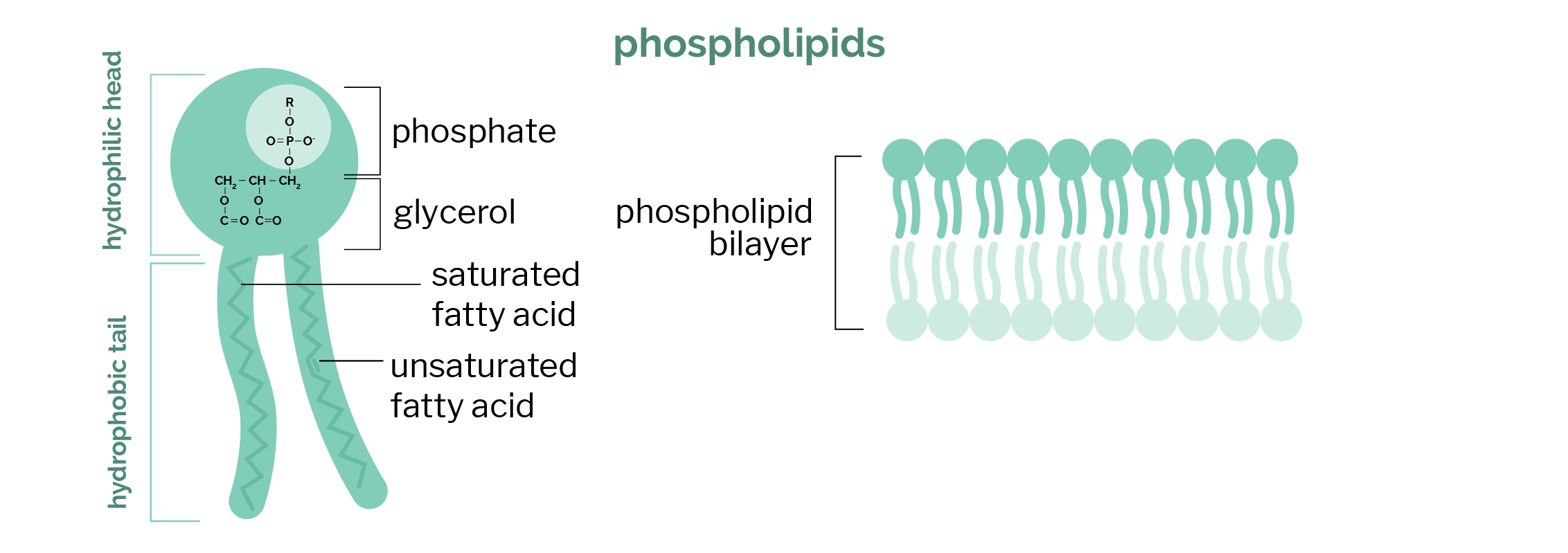
Spotlight on membrane proteins
Membrane proteins make up approximately a third of the proteome (the total protein content encoded by the genome) of living cells. Many diseases commonly associated with mutations are linked to malfunctions of these proteins, underscoring their medical importance.
“These proteins facilitate a range of biological processes such as the flow of molecules through and across membranes, responses to chemical messengers, and cell-to-cell communication within the human body,” Kuyler points out. “They function almost like ‘locks’ that only the right drug can open so as to access the cell and activate a response.”
The crucial role of membrane proteins in drug development is evident in the fact that they comprise such a large portion of all drug targets. But why, then, do we know so little about them?
“The problem lies in how difficult it is to isolate or remove membrane proteins from the cell membrane in order to study their structure and function in a biologically representative state,” Kuyler explains.
The native environment (i.e., the cell membrane) in which membrane proteins are embedded consists of two layers of phospholipids — molecules that each have a hydrophilic head and two hydrophobic tails. Their unique structure enables them to form the foundation of biological membranes.
For the accurate design of new therapeutics, membrane proteins need to be extracted in their unaltered, stable, and fully functional form from the lipid environment that makes up the cell membrane.
“The difficulties arise from the amphiphilic nature of membrane proteins and the consequent need to extract them in a way that stabilises both the hydrophobic and hydrophilic parts. If this is not achieved, the protein can lose its true structure and function.
“Understanding these aspects of drug targets can not only reduce the time and cost of drug development but also holds the potential to enhance the efficacy of drugs, ultimately minimising side effects and reducing the cost thereof,” says Kuyler.
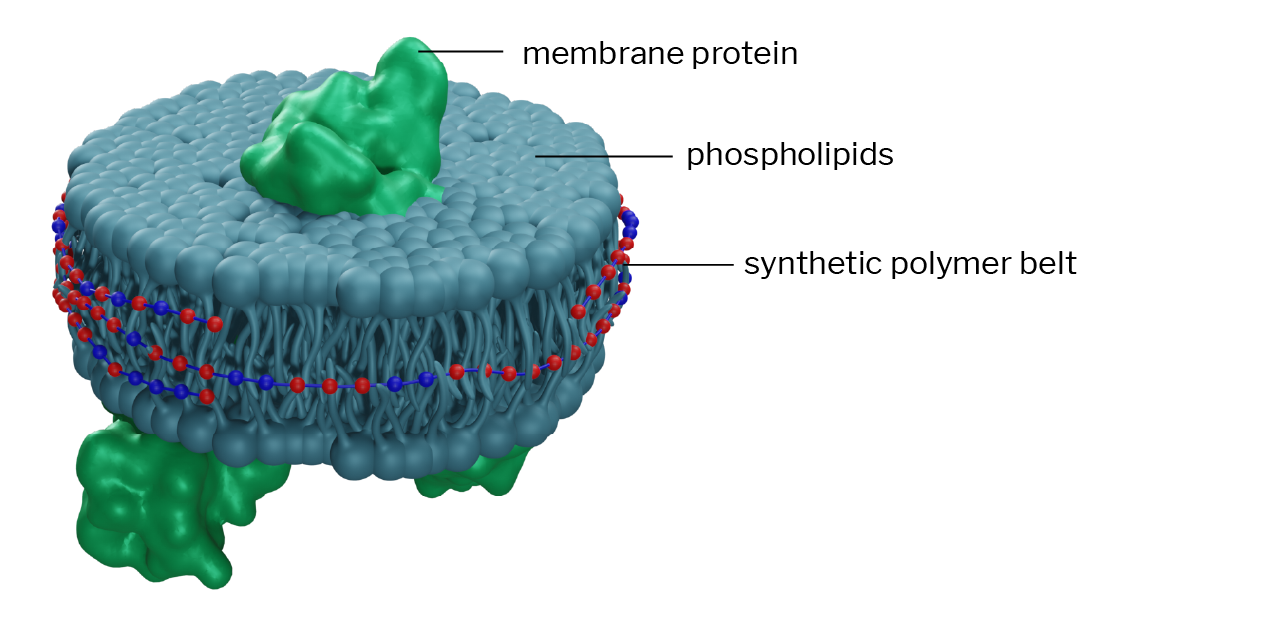
A visual representation of the flat, circular shape of a nanodisc containing membrane proteins. The nanodiscs enable some of the most valuable membrane proteins to be analysed in a native-like environment, while retaining their physiological properties. | Image courtesy of Nanosene (Pty) Ltd
Isolating membrane proteins, innovatively
Generally, technologies in the field of polymer science are related to high-volume, low-value manufacturing that requires significant manufacturing capabilities.
“With the advent of the new polymer-stabilised nanodisc technology, much focus is placed on low-volume, high-value products with a specific application,” Kuyler explains.The nanodisc technology opens up collaborative opportunities within the research community and in commercial partnerships.” She adds: “The advanced synthetic strategy that we employ is highly customisable, allowing for dedicated polymer design and various specialised application."
The term ‘nanodisc’ describes a disc-shaped particle, composed of phospholipids that are held together by a synthetic polymer belt. These tiny structures have dimensions as small as one-billionth of a metre (a nanometre) — invisible to the naked eye and most microscopes.
“Being able to operate at this scale enables us to understand and study the fundamental building blocks of materials and biological systems,” says Kuyler. Barnard adds: “Research at the nanoscale empowers us to utilise the unique properties of materials and drive innovation in various applications.”
The discs make the difficult-to-study membrane proteins amenable to analyses previously restricted to soluble proteins only. This is because, in these nanoscale discs, the water-insoluble component of amphipathic polymers can interact with and destabilise the cell membrane to isolate and stabilise membrane proteins along with their surrounding lipids.
This technology, therefore, offers researchers the unprecedented opportunity to access some of the most valued proteins in a biologically active state.
The Nanosene researchers use polymer-based molecular ‘cookie cutters’ to isolate the complex membrane proteins and keep them embedded within the portion of the cell membrane, thus preserving its molecular structure in its near-original context and stable form.
The nanodisc serves as a snapshot of the native environment that the membrane proteins had in the cell membrane. This is because water-soluble amphipathic polymers (containing both water-repellant and water-loving components) can interact with and enter the cell membrane to isolate and stabilise intact and functioning membrane proteins, along with their surrounding lipids, in these discs.
In contrast to soluble proteins, the amphipathic properties of membrane proteins prevent solubilisation in a standard water-based solution as the hydrophobic parts of the proteins bundle together to minimise contact with the solution.
“Until not too long ago and even right now, membrane proteins are being isolated with detergents,” Klumperman points out. “This leads to poor stability of the proteins and associated problems in their downstream use, such as for drug development and drug screening.”
“This undeniably changes the structure and folding of the membrane protein, typically hindering studies of its native form,” Kuyler explains. “This problem can, however, be addressed by using synthetic polymers to form polymer-stabilised nanodiscs.”
Nanosene produces polymers that have predetermined molecular weights with narrow chain length distributions and the possibility of having their hydrophilic-hydrophobic balance precisely fine-tuned. “This breakthrough technology can outperform conventional detergent-based methods [of isolating protein membranes] and holds the potential to empower researchers and drug developers to explore new avenues for treating various diseases.”Compared to other current materials, our material offers the possibility of introducing additional functionalities such as fluorescent labels, affinity tags, and tethered surfaces,” Klumperman explains in a recent video. Barnard adds: “We believe that by adopting our customised polymer solutions and substituting traditional techniques with our innovative methods will enhance the efficiency and effectiveness of identifying potential drug targets for new therapeutic development.”
How to stabilise membrane proteins in a native-like environment using polymer nanodiscs
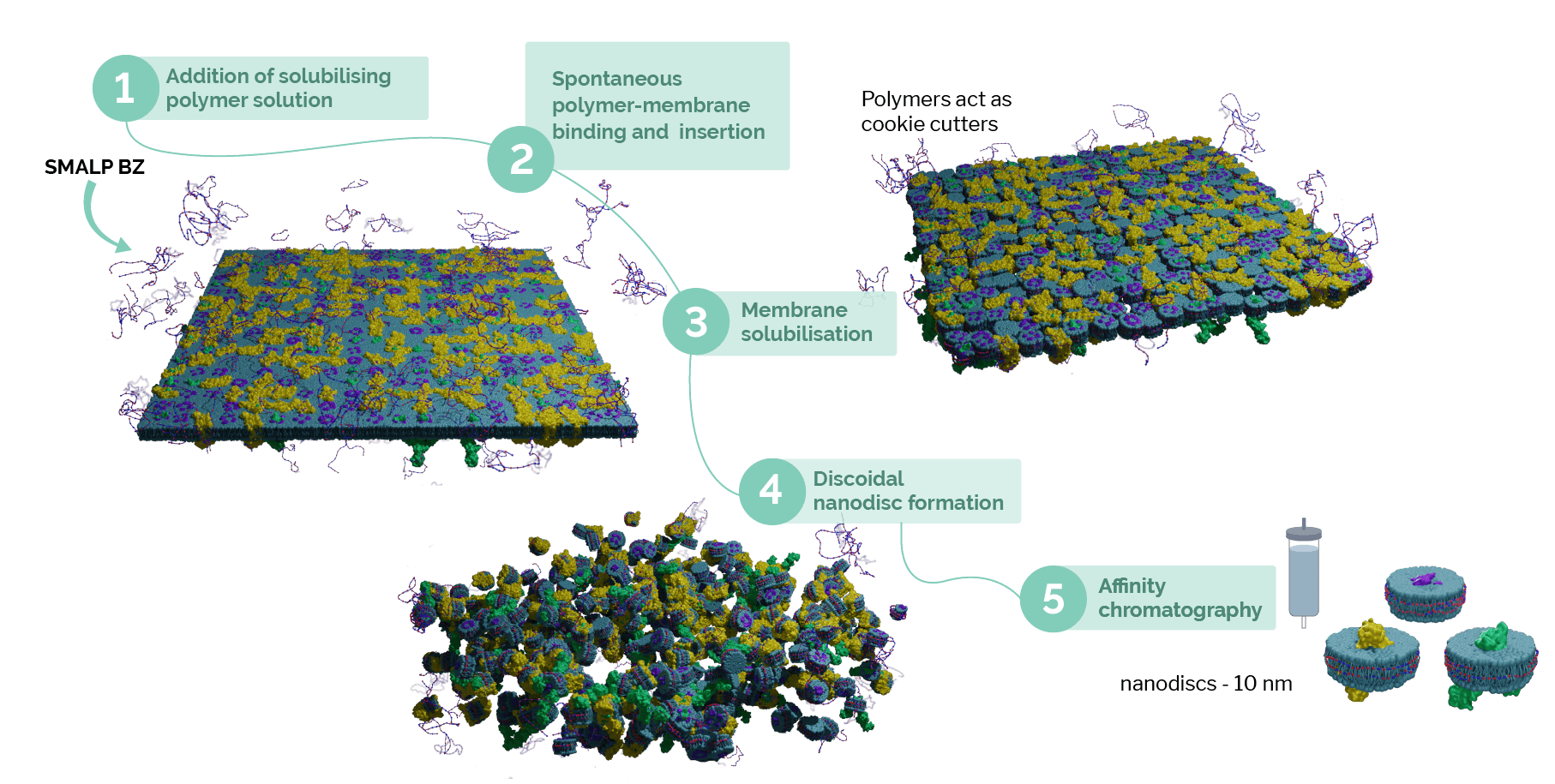
The synthetic polymer chain stabilises the membrane proteins within nanodiscs. This enables the analysis of these proteins in a native-like (cell) environment, while retaining their physiological properties. | Image courtesy of Nanosene (Pty) Ltd
Leading the (polymer) pack
Although Nanosene has only been operational since July 2023, the team are looking ahead with confidence. Given their recent achievements, they have every reason to be optimistic.
By developing novel polymers to isolate membrane proteins in a highly stable and functional form, Nanosene is positioned to make a significant contribution to the drug development industry.
Klumperman says, going forward, they will focus on two overarching areas: “One is the expansion of conditions under which our polymers can do their job. These conditions relate to the acidity or basicity of solutions and the presence of certain salts.
“The other area is the inclusion of additional functionalities in our polymers that will expand their use in common drug development techniques, such as surface plasmon resonance (used to measure how molecules interact with each other) and fluorescence spectroscopy (used to study the properties of substances that emit light).”
Barnard says their ongoing research and development projects are focused on creating amphiphilic copolymers (made from two or more different kinds of building blocks that are joined together) to address the limitations of the polymers currently available on the market.
“We’re also planning to expand our capabilities with customisable chemical modifications, which will open up new avenues and applications in drug discovery and development.
“As we move forward, we continuously seek and establish local and international partnerships and collaborations, both academic and industrial, for product testing, technology development and validation, and integration in new and existing applications.”
Detergent-free membrane protein isolation

Nanosene’s technology produces novel polymers that researchers use as tools for the solubilisation of intact, functional, biologically active membrane proteins in tiny nanoscale discs. | Image courtesy of Nanosene (Pty) Ltd
Carving out a research niche
As Africa’s first bespoke polymer innovator and supplier, Nanosene Pty (Ltd) already boasts some remarkable achievements.
In a joint effort, it serves as the official commercialisation avenue for potentially profitable innovations developed within SU’s Klumperman Research Group.
The company has commercialised its first polymers in collaboration with Cube Biotech, a leading German biotechnology company. The product launch was announced in October 2023 at the International Conference on Native Membrane Nanoparticles in the USA.
In February 2024, Nanosene emerged as the overall winner and public favourite at the Academia-Industry Training (AIT) Swiss-African Science and Business Innovators Conference in Lagos, Nigeria. The company was subsequently selected as one of the top 12 African start-ups to attend the AIT Swiss Residency Week in Switzerland in May.
In the same month, Nanosene was also one of eight South African start-ups selected to join the French Embassy’s South African delegation to VivaTechnology 2024 — Europe’s premier technology and innovation event, held in Paris. Here, the team had the opportunity to pitch their innovation on the AfricaTech stage and at the South African ambassador’s residence.
In addition, the start-up has been selected as a finalist in the science start-up category of a competition run by Falling Walls Venture (a global platform for showcasing entrepreneurial potential in science). The company is one of only two South African start-ups to be selected for this international event, standing out amongst a pool of over 1 100 nominations from more than 300 institutions.
Useful definitions
Polymers are synthetic materials composed of many monomers (from 10s to 1000s), linked together to form long, repeating chains. Polymers are used in a host of different products such as packaging, paint, and textiles, as well as for more advanced applications such as hydrogels, wound dressings, medical implants, and electronics.
Amphiphilic polymers are macromolecules that contain both hydrophobic (water-repellent) and hydrophilic (water-attracting) components, and play a crucial role in nanomedicine. As adept drug carriers, they ensure the stability and delivery of pharmaceuticals to their designated destinations.
Nanomedicine is the medical application of nanotechnology to achieve innovation in healthcare. It involves the use of specific types of structures at the nanoscale, generally understood as being 100 nanometres (100 millionths of a millimetre or 100 billionths of a metre) or less.
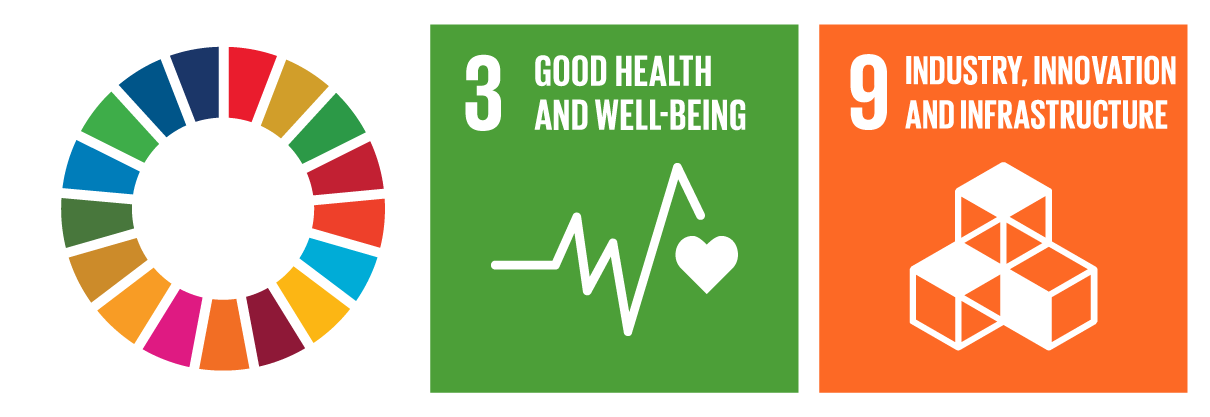
The research initiatives reported on above are geared toward addressing the United Nations’ Sustainable Development Goals number 3 and 9 and goals number 1 and 2 of the African Union’s Agenda 2063.
Useful links
SU’s Klumperman Research Group
SU’s Department of Chemistry and Polymer Science
SU’s Innovus Technology Transfer Office
Polymer innovator helps to transform world of medicine
Meet the SU scientist behind Africa’s first bespoke polymer supplier
SU chemist awarded R18 million from Wellcome Trust
Solving problems through polymer chemistry
X (formerly Twitter): @ChempolS, @BertKlumperman, @ScienceSUN, @MatiesResearch and @StellenboschUni